新手入门Java 方法带参,方法重载及面向对象和面向过程的区别介绍
第二章 方法带参
课前回顾
1.描述类和对象的关系
类是一组对象的共有特征和行为的描述。对象是类的其中一个具体的成员。
2.如何创建对象
类名 对象名 = new 类名();
3.如何定义和调用方法
public void 方法名(){
}
对象名.方法名();
4.成员变量和局部变量的区别
成员变量有初始值,而局部变量没有初始值。因此,局部变量在使用之前必须完成初始化。成员变量在整个类中可见,而局部变量只能在其所定义的方法中可见。因此,如果在方法中出现了与成员变量同名的局部变量,此时局部变量的优先级更高。
5.如何理解this关键字
this 关键字表示当前对象。那么当前对象究竟是什么?哪一个对象使用new关键字,那么this就指向哪个对象
Car c = new Car(); // this => c
Car c1 = new Car(); //this => c1
第一节 方法带参
1.构造方法带参
案例场景
现有计算机类定义如下:
public class Computer{
public String brand;//品牌
public String type;//型号
public double price;//价格
}
现要创建3个具体的计算机实例,代码如下:
public class ComputerText {
public static void main(String[] args){
Computer c1 = new Computer();
c1.brand = "联想";
c1.type = "T430";
c1.price = 5000;
Computer c2 = new Computer();
c2.brand = "联想";
c2.type = "w530";
c2.price = 6000;
Computer c3 = new Computer();
c3.brand = "联想";
c3.type = "T450";
c3.price = 7000;
}
}
思考:以上代码存在什么问题?
我们会发现没创建一个对象,都会出现重复为对象的属性赋值,这样造成大量的冗余代码。可以使用带参构造方法来进行优化。
构造方法带参语法
访问修饰符 类名(数据类型1 变量名1,数据类型2 变量名2,...数据类型n 变量名n){
}
示例
/**
* 计算机类
*
*/
public class Computer {
public String brand;//品牌
public String type;//型号
public double price;//价格
//如果一个类中没有定义任何构造方法,那么编译器会自动为这个类添加一个默认的无参构造方法
//如果一个类中已经定义了构造方法,那么编译器不会自动为这个类添加默认的无参构造方法
//如果一个类中已经定义了带参数构造方法,此时还想使用无参的构造方法,那么必须将无参构造方法也定义出来
public Computer(){}
//此时在类中定义了带参数的构造方法,那么编译器不会自动为这个类添加默认的无参构造方法
//构造方法的()中表示的是参数列表,这里的列表是形式参数
public Computer(String brand, String type, double price){
this.brand = brand;
this.type = type;
this.price = price;
}
}
public class ComputerText {
public static void main(String[] args){
Computer c1 = new Computer();
// c1.brand = "联想";
// c1.type = "T430";
// c1.price = 5000;
//调用带参构造方法创建对象时,必须注意参数列表传递的值要与构造方法定义时的值一一对应
//传递的参数是实参,也就是形式参数的一个具体实例
Computer c4 = new Computer("联想","T430",5000);
Computer c2 = new Computer();
// c2.brand = "联想";
// c2.type = "w530";
// c2.price = 6000;
Computer c5 = new Computer("联想","w530",6000);
Computer c3 = new Computer();
// c3.brand = "联想";
// c3.type = "T450";
// c3.price = 7000;
Computer c6 = new Computer("联想","T450",7000);
}
}
练习
定义书籍名(名称、出版社、出版年月、价格)并使用带参构造方法创建对象
/**
* 书籍类
*
*/
public class Book {
public String name; //书名
public String publishHome; //出版社
public String data; //出版年月
public double price; //价格
public Book(String name,String publishHome,String data,double price){
this.name = name;
this.publishHome = publishHome;
this.data = data;
this.price = price;
}
}
public class BookTest {
public static void main(String[] args) {
//作者乱编的哈~
Book b = new Book("云边有个小卖部","不知道出版社","2017/7/7",40);
}
}
2.方法带参
方法带参语法
//[]中的内容可有可无
访问修饰符 返回值类型 方法名(数据类型1 变量名1,数据类型2 变量名2,...数据类型n 变量名n){
[return 返回值]
}
//带参方法调用
对象名.方法名(实参1,实参2,...实参3);
return关键字的作用就是给出方法执行的结果,使得方法直接结束
案例场景
现有计算器类的定义如下:
public class Calculator {
public int number1;
public int number2;
public String operator;
/**
* 访问修饰符 返回值类型 方法名(数据类型1 变量名1,数据类型2 变量名2,...数据类型n 变量名n){
* [return 返回值]
* }
*
* return关键字的作用就是给出方法执行的结果,使得方法直接结束
*/
//calculate方法执行完成后必须要返回一个int类型的值
//如果一个方法的返回值类型不为void,那么在选择结构中,必须要为每一种情况都提供一个返回值
public int calculate(){
switch(operator){
case "+":
return number1 + number2;
case "-":
return number1 - number2;
case "*":
return number1 * number2;
case "/":
return number1 / number2;
default:
return 0;
}
}
}
某商家有30件啤酒,每件价格72元,商家在3天内卖完这30件啤酒,请问每天卖了多少钱?
/**
* 某商家有30件啤酒,每件价格72元,商家在3天内卖完这30件啤酒,请问每天卖了多少钱?
*
*/
public class Calculator {
public int number1;
public int number2;
public String operator;
public Calculator(){}
public int calculate(){
switch(operator){
case "+":
return number1 + number2;
case "-":
return number1 - number2;
case "*":
return number1 * number2;
case "/":
return number1 / number2;
default:
return 0;
}
}
}
public class CalculatorTest {
public static void main(String[] args) {
Calculator c = new Calculator();//构造一个计算器
c.number1 = 30;
c.number2 = 72;
c.operator = "*";
int total = c.calculate();//计算总收入
c.number1 = total;
c.number2 = 3;
c.operator = "/";
int avg = c.calculate();//计算每天的平均收入
System.out.println("每天卖了" + avg + "元");
}
}
思考:以上代码存在什么问题?
依然是为对象的属性重复赋值的问题,可以使用构造方法来解决
/**
* 某商家有30件啤酒,每件价格72元,商家在3天内卖完这30件啤酒,请问每天卖了多少钱?
*
*/
public class Calculator {
public int number1;
public int number2;
public String operator;
public Calculator(){}
public Calculator(int number1,int number2,String operator){
this.number1 = number1;
this.number2 = number2;
this.operator = operator;
}
public int calculate(){
switch(operator){
case "+":
return number1 + number2;
case "-":
return number1 - number2;
case "*":
return number1 * number2;
case "/":
return number1 / number2;
default:
return 0;
}
}
}
public class CalculatorTest {
public static void main(String[] args) {
Calculator c = new Calculator();//构造一个计算器
c.number1 = 30;
c.number2 = 72;
c.operator = "*";
int total = c.calculate();//计算总收入
c.number1 = total;
c.number2 = 3;
c.operator = "/";
int avg = c.calculate();//计算每天的平均收入
System.out.println("每天卖了" + avg + "元");
//用构造方法带参优化
Calculator c1 = new Calculator(30,70,"*");
int result1 = c.calculate();
Calculator c2 = new Calculator(result1,3,"/");
int result2 = c.calculate();
System.out.println("每天卖了" + result2 + "元");
}
}
仔细解读上面的代码,是否还存在问题?
上面的代码确实进行了优化,但是与现实生活不符。在现实生活中,要进行计算,只需要一台计算器即可,这里使用了两台计算器才能完成简单的计算功能。在这里还需要对代码进行改造,以满足实际生活的需要。可以使用带参方法来优化。
/**
* 某商家有30件啤酒,每件价格72元,商家在3天内卖完这30件啤酒,请问每天卖了多少钱?
*
*/
public class Calculator {
public int calculate(int number1,int number2,String operator){
switch(operator){
case "+":
return number1 + number2;
case "-":
return number1 - number2;
case "*":
return number1 * number2;
case "/":
return number1 / number2;
default:
return 0;
}
}
}
public class CalculatorTest {
public static void main(String[] args) {
Calculator c = new Calculator();
int total = c.calculate(30,72,"*");
int avg = c.calculate(total,3,"/");
System.out.println("每天卖了" + avg + "元");
}
}
练习
使用方法实现求任意数的阶乘。
import org.w3c.dom.ls.LSOutput;
import java.util.Scanner;
public class JieChengTest {
public static void main(String[] args) {
int number = 0;
int result = 0;
Scanner sc = new Scanner(System.in);
System.out.println("请输入一个数:");
while(true) {
if (sc.hasNextInt()) {
number = sc.nextInt();
JieCheng j = new JieCheng();
result = j.jiecheng(number);
break;
} else {
System.out.println("你输入的不是整数,请输入一个整数:");
sc.next();
}
}
System.out.println("这个数的阶乘是" + result);
}
}
使用方法实现判断一个数是否为素数。
public class IsPrime {
public boolean isprime(int n){
if(n == 2){
return true;
} else {
for(int i=2; i<n; i++){
if(n % i == 0){
return true;
}
}
}
return false;
}
}
import java.util.Scanner;
public class IsPrimeTest {
public static void main(String[] args) {
Scanner sc = new Scanner(System.in);
System.out.println("请输入一个整数:");
while(true){
if(sc.hasNextInt()){
int number = sc.nextInt();
IsPrime p = new IsPrime();
if(p.isprime(number)){
System.out.println(number + "不是素数");
} else {
System.out.println(number + "是素数");
}
break;
} else{
System.out.println("你输入的不是一个整数,请输入一个整数:");
sc.next();
}
}
}
}
3.对象数组
对象数组语法
类名[] 对象名 - new 类名[数组长度];//创建一个对象数组
案例场景
学生有姓名和年龄,类定义如下:
public class Student{
public String name;
public int age;
public Student(String name,int age){
this.name = name;
this.age = age;
}
}
一个班级有多个学生,如何存储这些学生的信息?使用数组存储
public class StudentTest {
public static void main(String[] args) {
Student[] students = new Student[2];
students[0] = new Student("张三",20);
students[1] = new Student("李四",25);
}
}

练习
使用对象数组存储学生选择的5门必修课程(课程编号、课程名称、学分)
/**
* 课程类
*
*/
public class Course {
public int number;
public String name;
public double score;
public Course(int number,String name,double score){
this.number = number;
this.name = name;
this.score = score;
}
}
public class CourseTest {
public static void main(String[] args) {
Course[] courses = new Course[5];
courses[0] = new Course(01,"数学",150);
courses[1] = new Course(02,"语文",150);
courses[2] = new Course(03,"英语",150);
courses[3] = new Course(04,"化学",100);
courses[4] = new Course(05,"生物",100);
}
}
使用对象数组存储5个菜单信息(菜单编号、菜单名称)
/**
* 菜单类
*
*/
public class Menu {
public int number;
public String name;
public Menu(int number,String name){
this.number = number;
this.name = name;
}
}
public class MenuTest {
public static void main(String[] args) {
Menu[] menus = new Menu[5];
menus[0] = new Menu(01,"黄焖鸡米饭");
menus[1] = new Menu(02,"土家酱香饼");
menus[2] = new Menu(03,"土豆泥拌面");
menus[3] = new Menu(04,"公安锅盔");
menus[4] = new Menu(05,"麻辣牛肉");
}
}
4.引用数据类型作为方法的参数
案例场景
某手机专卖店有100个手机展架,售货员现在依次向展架上摆放手机。请使用面向对象的设计思想描述这一过程。(手机有品牌、型号和价格)
分析
a.这一过程涉及到的对象有两个,一个是手机,一个是售货员,因此我们需要为这两个对象构建类
b.摆放手机是售货员的一个行为,因此需要使用方法来描述
c.100个手机展架放的都是手机,因此需要使用对象数组来存储
代码实现
public class Mobine {
public String brand;
public String type;
public double price;
public Mobine(String brand,String type,double price){
this.brand = brand;
this.type = type;
this.price = price;
}
}
public class Saler {
//数组中的默认值都是null
public Mobine[] mobines = new Mobine[100];
/**
* 引用数据类型作为方法的参数
*
*/
public void palyMobine(Mobine mobine){
for(int i=0; i<mobines.length; i++){
if(mobines[i] == null){
mobines[i] = mobine;
break;
}
}
}
}
public class SalerTest {
public static void main(String[] args) {
Saler saler = new Saler();
//调用售货员放手机
saler.palyMobine(new Mobine("小米","小米10",2000));
}
}
练习
某老师现要录入班级学生信息(姓名,性别,年龄,成绩),学生信息存储在数组中。请使用方法完成。
分析:
a.涉及的对象(具体的事物):老师和学生,需要构建两个类来描述这样的对象的共同特征和行为举止
b.录入班级学生信息是老师的行为
c.学生信息存储在数组中
import java.util.Arrays;
import java.util.Scanner;
public class Stu {
public String name;
public String sex;
public int age;
public double score;
public Stu(String name,String sex,int age,double score){
this.name = name;
this.sex = sex;
this.age = age;
this.score = score;
}
}
public class Teacher {
public Stu[] stus = {}; //刚开始的时候 一个学生也没有
public void addStu(Stu stu){//添加一个学生信息
stus = Arrays.copyOf(stus,stus.length + 1); //先对数组进行扩容
stus[stus.length - 1] = stu;
}
}
public class TeacherTest {
public static void main(String[] args) {
Scanner sc = new Scanner(System.in);
Teacher t = new Teacher(); //一位老师
for(int i=0; i<3; i++){ //输入3个学生的信息
System.out.println("请输入学生姓名:");
String name = sc.next();
System.out.println("请输入学生性别:");
String sex = sc.next();
System.out.println("请输入学生年龄:");
int age = sc.nextInt();
System.out.println("请输入学生成绩:");
double score = sc.nextDouble();
// Stu stu = new Stu(name,sex,age,score);
// t.addStu(stu);
t.addStu(new Stu(name,sex,age,score));//将上面两步可以合二为一
}
}
}
5.数组作为方法的参数
案例场景
现有甲乙丙三个班级成绩统计如下:
甲:80,72,85,67,50,76,95,49
乙:77,90,92,89,67,94
丙:99,87,95,93,88,78,85
现要求将每个班的成绩从高到低依次排列。
import java.util.Arrays;
/**
* 现有甲乙丙三个班级成绩统计如下:
* 甲:80,72,85,67,50,76,95,49
* 乙:77,90,92,89,67,94
* 丙:99,87,95,93,88,78,85
* 现要求将每个班的成绩从高到低依次排列。
*
*/
public class ArraySort {
public static void main(String[] args) {
int[] arr1 = {80,72,85,67,50,76,95,49};
int[] arr2 = {77,90,92,89,67,94};
int[] arr3 = {99,87,95,93,88,78,85};
//可以使用冒泡排序来对数组中的元素进行降序排列
sortDesc(arr1);
System.out.println(Arrays.toString(arr1));
sortDesc(arr2);
System.out.println(Arrays.toString(arr2));
sortDesc(arr3);
System.out.println(Arrays.toString(arr3));
}
public static void sortDesc(int[] arr){
for(int i=0; i<arr.length; i++){
for(int j=0; j<arr.length-i-1; j++){
if(arr[j] < arr[j+1]){
int temp = arr[j];
arr[j] = arr[j+1];
arr[j+1] = temp;
}
}
}
}
}
练习
使用方法来完成菜单数组的显示功能。
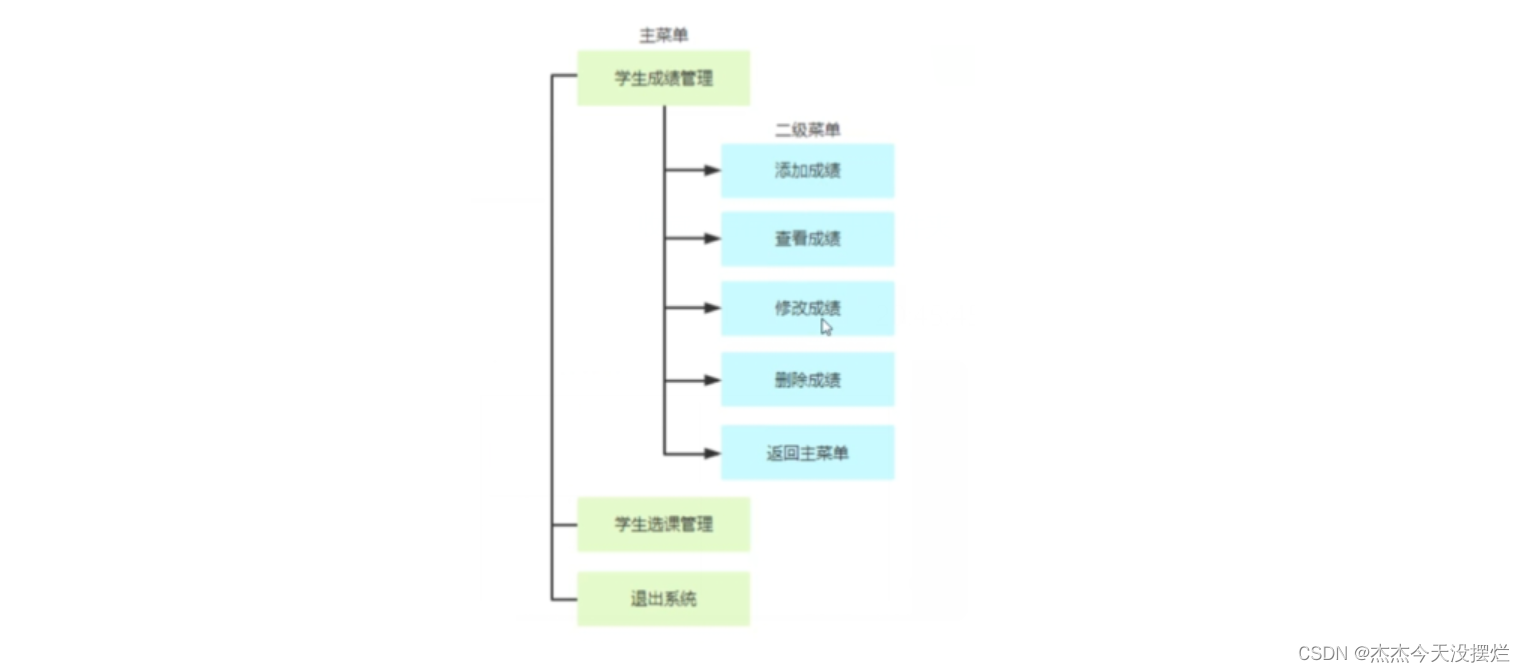
/**
* 菜单类
*
*/
public class Menu {
public int order; //编号
public String name; //名称
public Menu(int order,String name){
this.order = order;
this.name = name;
}
public void show(){
System.out.println(order + "." + name);
}
}
public class MenuArray {
public static void main(String[] args) {
Menu[] mainMenus = {
new Menu(1,"学生成绩管理"),
new Menu(2,"学生选课管理"),
new Menu(3,"退出系统"),
};
Menu[] secondMenus = {
new Menu(1,"增加成绩"),
new Menu(1,"修改成绩"),
new Menu(1,"删除成绩"),
new Menu(1,"查询成绩"),
new Menu(1,"返回主菜单"),
};
showMenus(mainMenus); //显示主菜单
showMenus(secondMenus); //显示第二菜单
}
public static void showMenus(Menu[] menus){
for(int i=0; i<menus.length; i++){
menus[i].show();
}
}
}
6.方法参数传递规则
Primitive arguments, such as an int or a double, are passed into methods by value. This means that any changes to the values of the parameters exist only within the scope of the method. When the method returns, the parameters are gone and any changes to them are lost.
基本数据类型的参数(例如int或double)按值传递给方法。这意味着当方法返回时,传入的引用仍然引用与以前相同的对象。但是,如果对象的字段的值具有适当的访问级别,则可以在方法中更改它们。
Reference data type parameters, such as objects, are also passed into methods by value. This means that when the method returns, the passed-in reference still references the same object as before. However, the values of the object's fields can be changed in the method, if they have the proper access level.
引用数据类型参数(例如对象)也按值传递到方法中。这意味着当方法返回时,传入的引用仍然引用与以前相同的对象。但是,如果对象的字段的值具有适当的访问级别,则可以在方法中更改它们。
基本数据类型传值案例
public class PassingPrimitive {
public static void main(String[] args) {
int a = 10;
change(a);//调用方法时,实际上传递的是变量a的值的拷贝
System.out.println(a);
}
public static void change(int number){
number++;
}
}
编译结果为:

思考:为什么基本数据类型a进入方法后值没有被修改?
这是因为基本数据类型传值时传递的是值的拷贝(或者理解为值的副本)
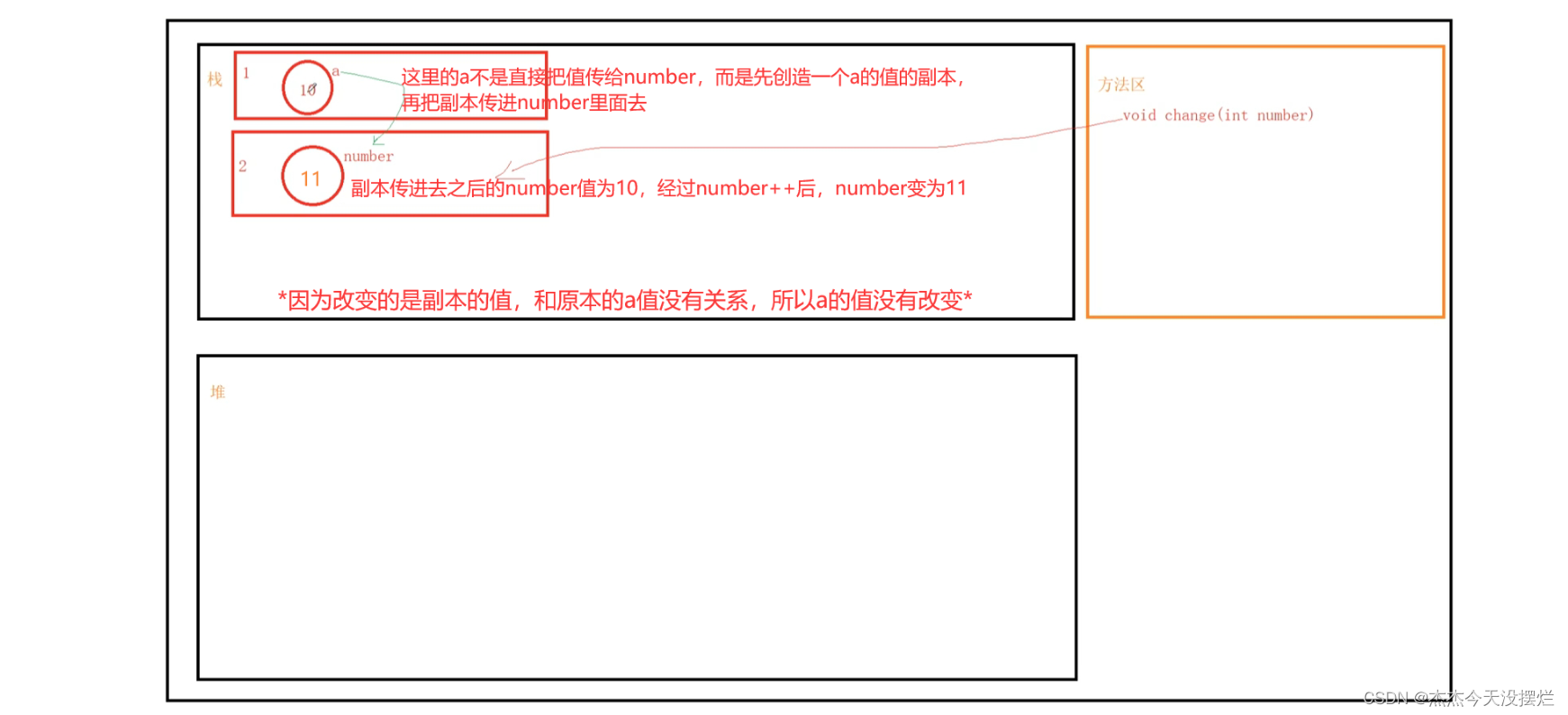
副本中的a值再怎么变化,和原来的a值没关系。
引用数据类型传值案例
/**
* 计算机类
*
*/
public class Computer {
public String brand;//品牌
public String type;//型号
public double price;//价格
public Computer(){}
public Computer(String brand, String type, double price){
this.brand = brand;
this.type = type;
this.price = price;
}
}
public class ComputerText {
public static void main(String[] args){
Computer c1 = new Computer();
c1.brand = "联想";
c1.type = "T430";
c1.price = 5000;
Computer c2 = new Computer();
c2.brand = "联想";
c2.type = "w530";
c2.price = 6000;
Computer c3 = new Computer();
c3.brand = "联想";
c3.type = "T450";
c3.price = 7000;
//这里传递的参数就是实际参数
Computer c4 = new Computer("联想","T430",5000);
updatComputer(c4);
System.out.println(c4.price);
Computer c5 = new Computer("联想","w530",6000);
Computer c6 = new Computer("联想","T450",7000);
}
public static void updataComputer(Computer computer){
computer.price = 10000;
}
}
编译结果为:
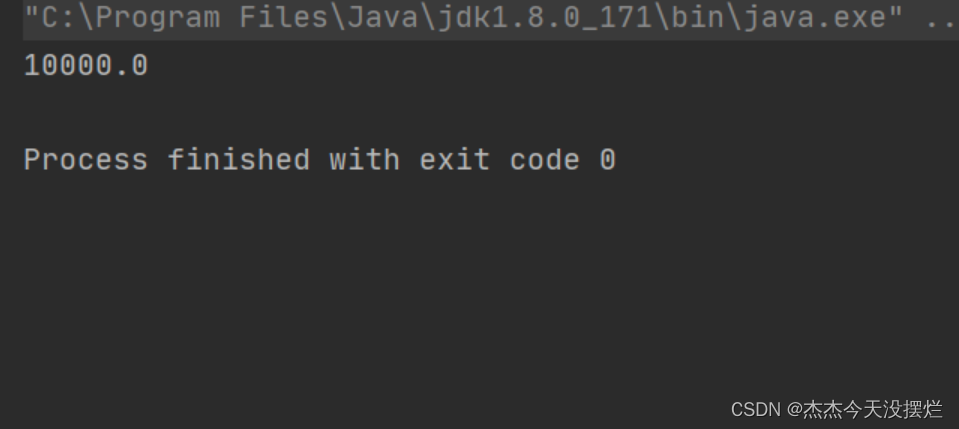
思考:为什么引用数据类型进入方法后值就就行了修改?
这是因为引用数据类型传值时传递的是对象在堆内存上的空间地址(或者理解为值的副本)
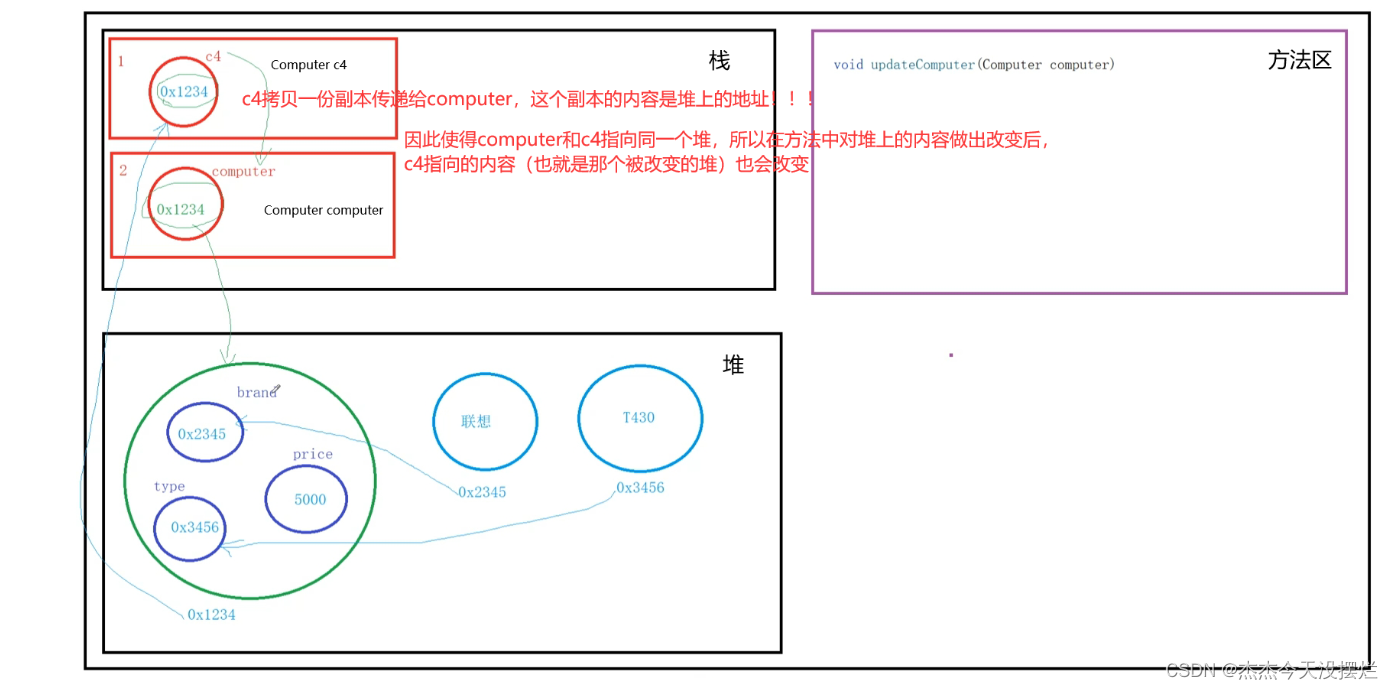
第二节 方法重载(Overloa)
1.概念
在同一个类中,方法名相同,参数列表不同的多个方法构成方法重载(只看方法名和参数列表)
2.示例
public class Calculator{
public int sum(int a,int b){
return a + b;
}
public int sum(int a,int b,int c){
return a + b + c;
}
}
3.误区
下面的方法是否属于方法重载?

不属于方法重载,因为方法名和参数列表都一样,在同一个类中,不可能出现这样的方法定义

不属于方法重载,因为方法名和参数列表都一样,在同一个类中,不可能出现这样的方法定义

属于方法重载,在同一个类中,方法名相同,参数列表不一样。
4.构造方法重载
构造方法也是方法,因此构造方法也可以重载。如果在一个类中出现了多个构造方法的定义,那么这些构造方法就形成构造方法重载。
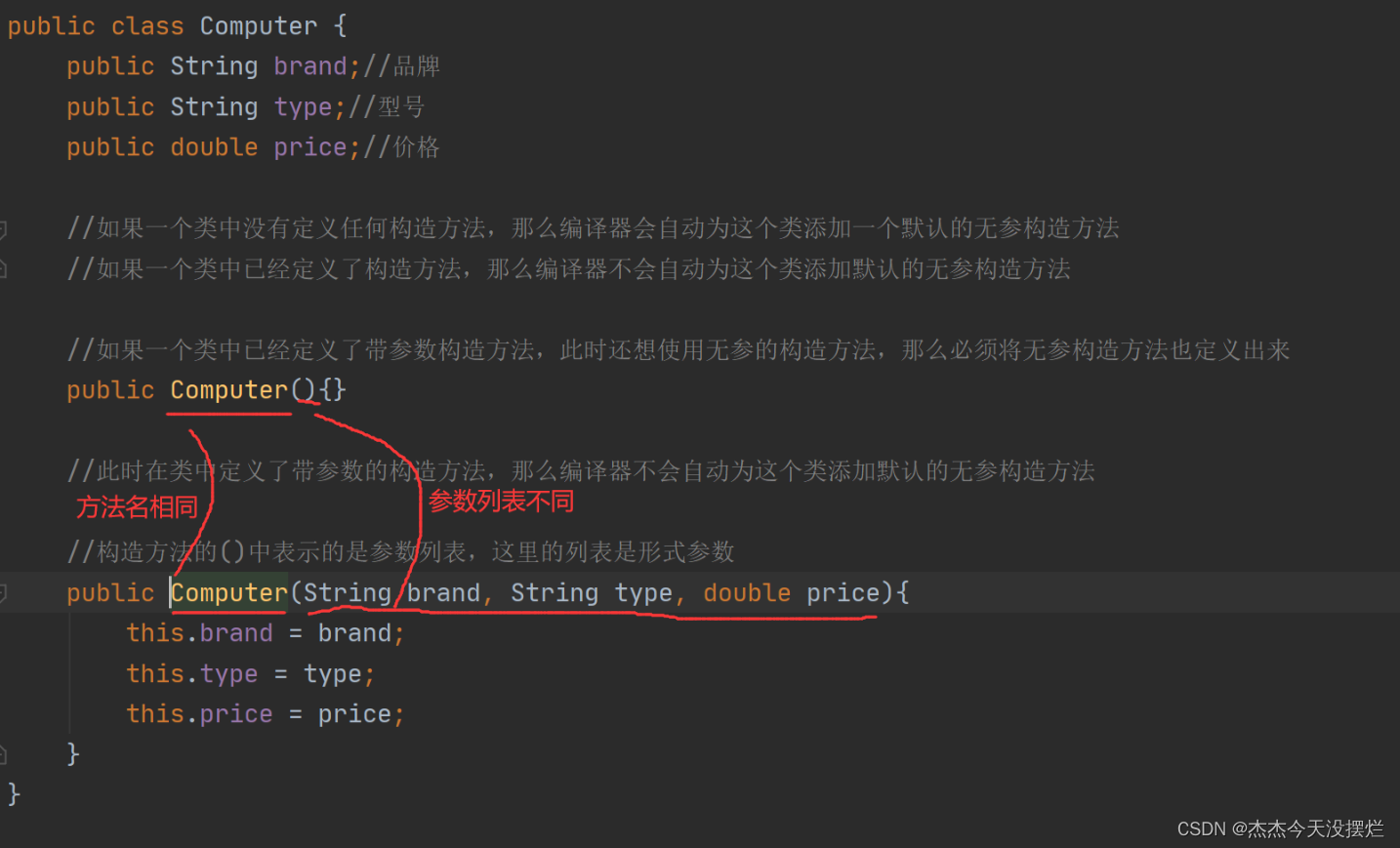
this关键字可以调用构造方法,但是必须是这个构造方法中的第一条语句
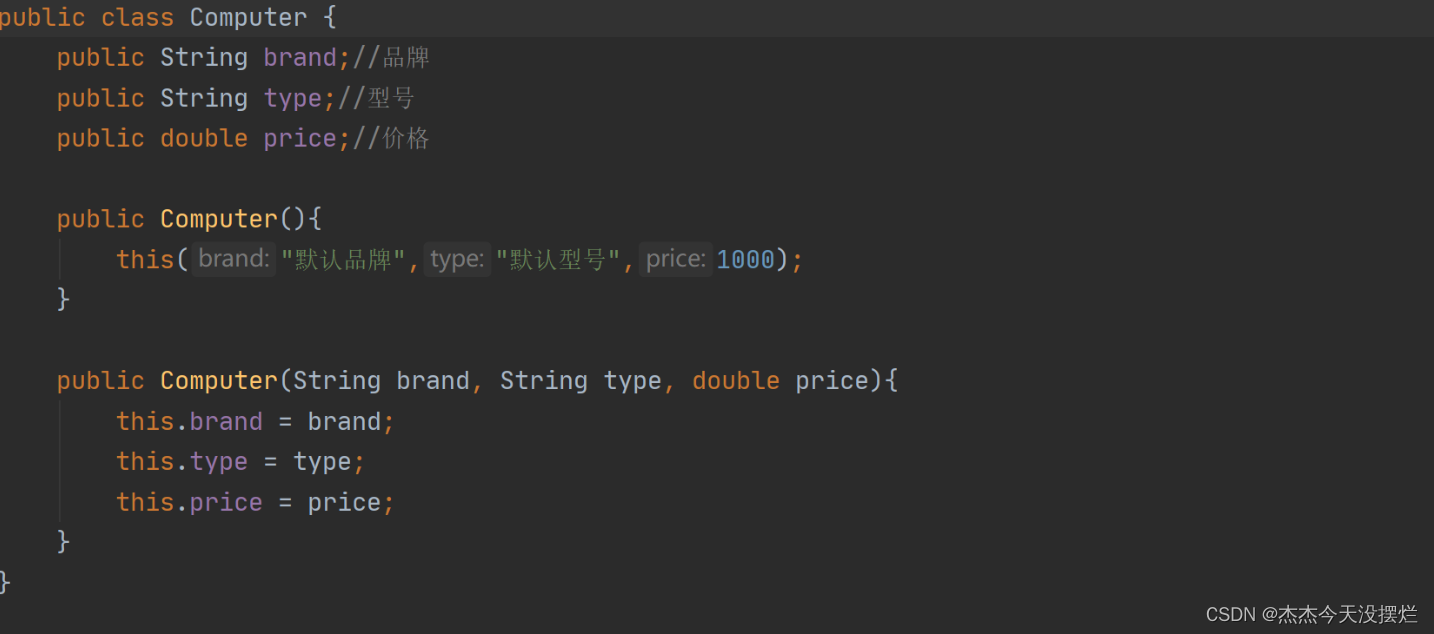
第三节 面向对象和面向过程的区别
1.案例
级联菜单展示
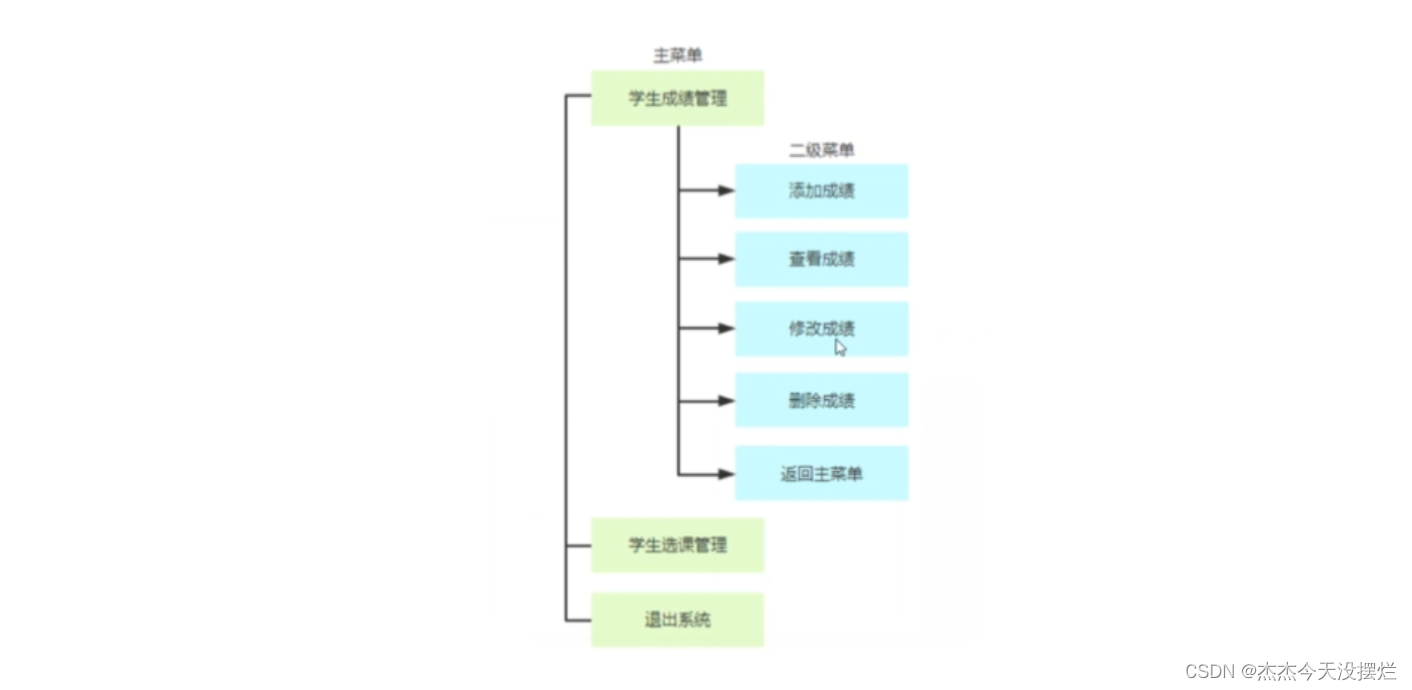
2.代码实现
面向过程
import java.util.Scanner;
/**
* Procedure Oriented Program 面向过程编程
*
*/
public class POP {
public static void main(String[] args) {
Scanner sc = new Scanner(System.in);
while(true) {
System.out.println("1.学生成绩管理");
System.out.println("2.学生选课管理");
System.out.println("3.退出系统");
System.out.println("请选择菜单编号:");
int number = sc.nextInt();
if(number == 1){
outer:
while(true) {
System.out.println("1.增加成绩");
System.out.println("2.修改成绩");
System.out.println("3.删除成绩");
System.out.println("4.查询成绩");
System.out.println("5.返回主菜单");
System.out.println("请输入菜单编号:");
int order = sc.nextInt();
switch(order){
case 1:
System.out.println("你选择了增加成绩");
break;
case 2:
System.out.println("你选择了修改成绩");
break;
case 3:
System.out.println("你选择了删除成绩");
break;
case 4:
System.out.println("你选择了查询成绩");
break;
case 5:
break outer;
}
}
} else if(number == 2){
System.out.println("你选择了学生选课管理");
} else {
System.out.println("感谢使用XXX系统");
break;
}
}
}
}
面向对象
分析:
a.该过程涉及到的对象(事物)有两个:用户和菜单
b.用户拥有执行增删改查的动作
/**
* 菜单类
*
*/
public class Menu {
public int order; //编号
public String name; //名称
public Menu(int order,String name){
this.order = order;
this.name = name;
}
public void show(){
System.out.println(order + "." + name);
}
}
/**
* 用户类
*
*/
public class User {
public void addScore(){
System.out.println("你选择了增加成绩");
}
public void deleteScore(){
System.out.println("你选择了删除成绩");
}
public void updateScore(){
System.out.println("你选择了修改成绩");
}
public void searchScore(){
System.out.println("你选择了查询成绩");
}
}
import java.util.Scanner;
/**
* Object Oriented Programming 面向对象编程
*
*/
public class OOP {
public static Menu[] mainMenus = {
new Menu(1,"学生成绩管理"),
new Menu(2,"学生选课管理"),
new Menu(3,"退出系统"),
};
public static Menu[] secondMenus = {
new Menu(1,"增加成绩"),
new Menu(2,"修改成绩"),
new Menu(3,"删除成绩"),
new Menu(4,"查询成绩"),
new Menu(5,"返回主菜单"),
};
public static Scanner sc = new Scanner(System.in);
public static User user = new User();
public static void main(String[] args) {
gotoMain();
}
//去主菜单
public static void gotoMain(){
showMenus(mainMenus);//显示主菜单
int number = sc.nextInt();
if(number == 1){
gotoSecond();
} else if(number == 2){
System.out.println("你选择了学生选课管理");
gotoMain();//去主菜单
} else {
System.out.println("感谢使用XXX系统");
}
}
//去二级菜单
public static void gotoSecond(){
showMenus(secondMenus);//显示二级菜单
int order = sc.nextInt();
switch (order){
case 1:
user.addScore();//用户增加成绩
gotoSecond();
break;
case 2:
user.updateScore();//用户修改成绩
gotoSecond();
break;
case 3:
user.deleteScore();//用户删除成绩
gotoSecond();
break;
case 4:
user.searchScore();//用户查询成绩
gotoSecond();
break;
case 5:
gotoMain();
break;
}
}
public static void showMenus(Menu[] menus){
for(int i=0; i<menus.length; i++){
menus[i].show();
}
System.out.println("请选择菜单编号:");
}
}
对比
r == 1){
gotoSecond();
} else if(number == 2){
System.out.println(“你选择了学生选课管理”);
gotoMain();//去主菜单
} else {
System.out.println(“感谢使用XXX系统”);
}
}
//去二级菜单
public static void gotoSecond(){
showMenus(secondMenus);//显示二级菜单
int order = sc.nextInt();
switch (order){
case 1:
user.addScore();//用户增加成绩
gotoSecond();
break;
case 2:
user.updateScore();//用户修改成绩
gotoSecond();
break;
case 3:
user.deleteScore();//用户删除成绩
gotoSecond();
break;
case 4:
user.searchScore();//用户查询成绩
gotoSecond();
break;
case 5:
gotoMain();
break;
}
}
public static void showMenus(Menu[] menus){
for(int i=0; i<menus.length; i++){
menus[i].show();
}
System.out.println("请选择菜单编号:");
}
}
<font color = "blue">对比</font>
面向过程侧重点在过程的实现上,面向对象侧重点在对象上,需要利用对象的行为来完成过程的组装。
本文来自互联网用户投稿,该文观点仅代表作者本人,不代表本站立场。本站仅提供信息存储空间服务,不拥有所有权,不承担相关法律责任。 如若内容造成侵权/违法违规/事实不符,请联系我的编程经验分享网邮箱:chenni525@qq.com进行投诉反馈,一经查实,立即删除!
- Python教程
- 深入理解 MySQL 中的 HAVING 关键字和聚合函数
- Qt之QChar编码(1)
- MyBatis入门基础篇
- 用Python脚本实现FFmpeg批量转换
- 3分钟让你学会axios在vue项目中的基本用法(建议收藏)
- 【setDS】牛客小白月赛83 E
- CEC2017(Python):六种算法(PSO、DBO、HHO、SSA、DE、GWO)求解CEC2017(提供完整Python代码)
- EMD、EEMD、FEEMD、CEEMD、CEEMDAN的区别、原理和Python实现(五)CEEMDAN
- 李沐深度学习-激活函数文档
- 办公网络建设项目说明
- 谷歌大裁员,3 万员工面临被 AI 取代;网易、暴雪疑似「复合」!丨 RTE 开发者日报 Vol.113
- 第7章-命令行操作基础
- 永恒之蓝漏洞复现
- web前端javaScript笔记——(7)Math和Date方法